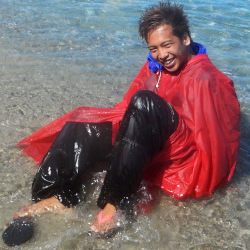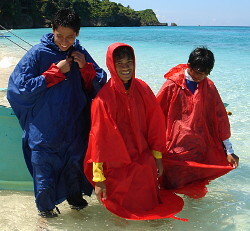Clothes for Carefree Beach Fun
The beauty of quick drying hiking clothes is that you can go in and out of the water when you like, enjoying a carefree time on the beach.
Your hiking cape is not only your rain ally but also your sun shield. So, whether you’re navigating tropical waters or lounging on a pristine beach, your trusty cape has you covered! 🌞🌊🏝️
Stay safe on the beach and avoid sunburn and jellyfish. A thin hiking cape, unlined nylon pants, and maybe an anorak underneath is all you need for carefree fun in and out of the water.
Lightweight Materials
Hiking capes and ponchos are intentionally crafted from lightweight materials.
Unlike thick rain jackets, which can retain moisture,
they dry quickly due to their thinner fabric.
When you emerge from the water after swimming or wading, they shed water quickly.
Ventilation and Airflow
Ponchos offer better ventilation than traditional rain jackets. Their loose fit allows air to circulate, expediting the drying process. As you move, the breeze passes through the poncho, evaporating any residual moisture. This feature is especially advantageous in humid environments like rainforests.
Hydrophobic Coatings
Some hiking ponchos come with hydrophobic coatings. These coatings repel water, ensuring that droplets bead up and roll off the fabric. As a result, the poncho remains relatively dry even when exposed to rain or splashes.


Practical Tips for Swimming in Your Hiking Poncho
When it comes to wearing a hiking poncho in the water on tropical beaches, here are some practical tips to keep in mind:
Choose the Right Poncho
Opt for a lightweight, waterproof poncho that is specifically designed for hiking. Look for one with good water resistance and breathability. Consider a poncho that covers your legs as well, providing extra protection from splashes and wet sand.
Breathability Matters
Tropical climates can be hot and humid.
Look for a poncho with high breathability
to avoid discomfort.
Ensure your other clothing layers are also made of lightweight, breathable materials.
Easy to Put On and Take Off
A poncho should be easy to slip on and off, especially when you’re transitioning between the beach and the water. Choose a design that allows for quick adjustments without fuss.
Secure It Properly
Tie the poncho securely around your waist or use any built-in fasteners to prevent it from flapping in the wind. Make sure it won’t get tangled or hinder your movement while swimming or wading.
Keep Valuables Dry
Use the poncho’s front pocket or a waterproof pouch to store your phone, wallet, and other valuables.
Seal them tightly to prevent water damage.
Versatility
A poncho is like a wearable umbrella or can be used as an emergency shelter. If you’re caught in unexpected rain or need shade, set it up as a makeshift tarp. It provides an all-in-one solution for staying safe in unpredictable weather. If the weather permits, leave it unzipped to maximize ventilation.


Sun Protection
Stay safe in the sun. Your hiking cape can double up as a sun shield, yet is more airy than tight lycra clothes. While your poncho provides sun protection, it is essential to apply sunscreen to any exposed skin. Don’t forget your sunglasses to shield your eyes from UV rays.


After Swimming or Wading

When you come out of the water, give your poncho a good shake to remove most water. Wear it in the sun or a breezy area.

With your arms inside, swing them as you walk along the beach. The airflow will aid in drying.

Wait until it is dry before you stow it away, otherwise it may rot. Then fold and pack it efficiently to save space in your backpack.